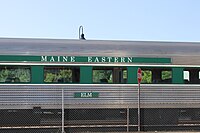Brunswick, Maine
Brunswick is included in the Lewiston-Auburn, Maine metropolitan New England city and town area.
Settled in 1628 by Thomas Purchase and other fishermen, the area was called by its Indian name, Pejepscot, meaning "the long, rocky rapids part [of the river]".
During the war, in Major Benjamin Church's second expedition a year later, he arrived on September 11, 1690, with 300 men at Casco Bay.
He went up the Androscoggin River to Fort Pejepscot (present day Brunswick, Maine).
A few days later, in retaliation, the natives attacked Church at Cape Elizabeth on Purpooduc Point, killing seven of his men and wounding 24 others.
The 1713 Treaty of Portsmouth brought peace to the region between the Abenaki Indians and the English colonists.
In 1724, 208 English colonial militia left Fort Richmond and sacked Norridgewock during Dummer's War.
[7] The Androscoggin River falls in three successive stages for a total vertical drop of 41 feet (12 m), providing water power for industry.
Other firms produced paper, soap, flour, marble and granite work, carriages and harness, plows, furniture, shoes and confections.
Bean, Bath Iron Works, as well as companies that produce fiberglass construction material and electrical switches.
A number of health services providers serving Maine's mid-coast area are located in Brunswick.
Brunswick has a number of historic districts recognized on the National Register of Historic Places: The book Uncle Tom's Cabin was written by Harriet Beecher Stowe while she was living in Brunswick, during the time that her husband was a professor at Bowdoin.
As of the census[2] of 2010, there were 15,175 people, 7,183 households, and 6,498 families residing in the census-designated place of Brunswick.







